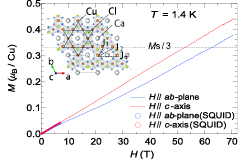High-field Magnetization Study of the S = 1/2 Kagome Lattice Antiferromagnet CaCu3(OH)6Cl2·0.6H2O
H. Yoshida, Y. Narumi, and M. Hagiwara
Seeking the quantum spin liquid state has been one of the central issues of the condensed matter physics. Various theories expected to realize the quantum spin liquid state on the Kagome lattice antiferromagnet owing to the strong frustration and the quantum fluctuation. Recently, the appearance of non-trivial magnetization plateaus at (2n + 1)Ms/9 for the S = 1/2 Kagome lattice antiferromagnet was predicted by the grand canonical DMRG [1] and Tensor network method [2], and thus the study of the magnetization curves of the Kagome lattice antifferomagnet has been of significant interest. However, the lack of appropriate model compounds is one of the difficulties to understand the magnetic properties of Kagome lattice antiferromagnet in the high magnetic fields.

Fig. 1. The magnetization curves measured on the single crystal of CaCu3(OH)6Cl2·0.6H2O at 1.4 K up to the magnetic field of 71 T. The dashed line is the guide to the eye for the 1/3 magnetization of the saturation moment of S = 1/2. The inset shows the schematic illustration of the Kagome layer of CaCu3(OH)6Cl2·0.6H2O with the magnetic interactions J1, J2, and Jd.
Recently, we have succeeded to prepare the single crystal of S = 1/2 Kagome lattice antiferromagnet CaCu3(OH)6Cl2·0.6H2O which has the perfect Kagome lattice without an anti-site disorder [3]. This compound possesses magnetic interactions of the nearest neighbor interaction J1, and the next nearest neighbor J2, and the Jd across the hexagon as shown in the inset of Fig. 1. Thus, an emergence of a novel magnetic state on the Kagome lattice is expected by the competition of the magnetic interactions. In this study, we report on magnetic properties of the single crystal of CaCu3(OH)6Cl2·0.6H2O revealed by the magnetic susceptibility, heat capacity, and high-field magnetization measurements [3].
The magnetic interactions of antiferromagnetic J1 = 52.2 K, Jd = 11.9 K, and ferromagnetic J2 = −6.9 K were extracted from the 9th order high temperature series expansion analysis. The magnetic susceptibility and the heat capacity measurements indicated that an occurrence of an unusual magnetic transition at T* = 7.2 K where only the χab showed the cusp and the heat capacity exhibited the tiny peak anomaly. The cusp in the χab disappeared above around 5 T, and it exhibited temperature independent behavior below T*. Remarkably, in spite of the fact that the compound is an insulator, the temperature-linear term 5.9 mJ/CumolK2 at H = 0 T was observed in the heat capacity which was suppressed by the magnetic field around 10 T. This suggests that the unconventional magnetic excitation underlies on the ground state of CaCu3(OH)6Cl2·0.6H2O [3].
Figure 1 shows the magnetization curves for both H // ab-plane and H // c-axis at 1.4 K up to 71 T. The magnetization along the c-axis increases monotonously. In contrast, a slope of the curve for H // ab-plane becomes small above 5 T which may correspond to the disappearing of the cusp in χab and the T-linear term in the magnetic field, and one can clearly see the upward convex feature above the 5 T anomaly. No meta-magnetic transitions and magnetization plateau at Ms/9 and Ms/3 for both directions were found. This may be attributed to the effect of the magnetic interactions J2 and Jd which has not been considered in the theoretical calculations[1,2]. In order to clarify the magnetic properties of the S = 1/2 ideal Kagome lattice antiferromagnet, the magnetization measurement in the much higher field, microscopic measurements such as high-field ESR and theoretical investigation are required.
References
- [1] S. Nishimoto et al., Nature Communs., 4, 2287 (2013).
- [2] T. Picot et al., Phys. Rev. B, 93, 060407(R) (2016).
- [3] H. Yoshida et al., J. Phys. Soc. Jpn., 86, 033704 (2017).
